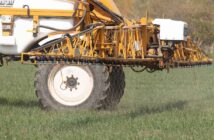The farmland market in England and Wales is holding steady in the face of mounting sector pressures, according to the latest results from the Knight Frank Farmland Index. Despite wider challenges across the agricultural sector and ongoing policy uncertainty, values have remained largely stable, underlining the market’s resilience.
The index, which tracks the average price of bare agricultural land (arable and pasture) across England and Wales, shows a marginal drop of 1% in the first quarter of 2025 to £9,072/acre. This follows a similar small decline in the final quarter of 2024, bringing the annual change to just -1.9%.
“While farmer protests and policy reform have dominated headlines, the farmland market itself has experienced a fairly uneventful start to the year,” says Will Matthews, partner and head of farms and estates. “Values have remained steady, and relatively few new properties have been put up for sale so far in 2025.”
Just over 8,000 acres have been publicly launched during the first quarter – a drop of 11% compared with the same period last year.
While there has been speculation that the proposed reform of Inheritance Tax (IHT), due to come into effect in April 2026, could affect land values, Will says the market has not yet responded with any significant increase in supply or signs of downward price pressure.
“Prospective buyers seem relatively sanguine about the reforms, and we completed a number of successful transactions in March,” he explains. “Farmland continues to trade at near-record prices, and while deals may have proceeded regardless, the arrival of spring sunshine has certainly lifted spirits and helped bring renewed momentum to the market.”
“A large block of land in the Midlands, for example, sold for around £13,000/acre to a progressive farming business, with most other sales breaking the £10,000/acre barrier.”
Will also points to more immediate concerns, including the big drops that farmers will see in their Basic Payment Scheme (BPS) cheques and uncertainty surrounding the future of the government’s environmental payment schemes.
“The current round of the Sustainable Farming Incentive (SFI), which would have helped to offset some BPS losses, was recently closed without notice, with many producers still to get their applications in. Again, however, it is too early to say if this will result in more landowners deciding to call it a day and put all or part of their holdings up for sale,” he says.
Even if more land does come to the market, Will emphasises that demand remains strong. “Forward-looking farmers, in particular those with diversified income streams, investors and environmental buyers continue to drive interest. For now, the farmland market appears to be holding firm.”
“Perhaps by the end of the year we’ll have more clarity regarding the impact of the government’s policy changes on land values,” concludes Will. “But, so far, it seems to be business as usual for the sector of the market that we deal in.”




